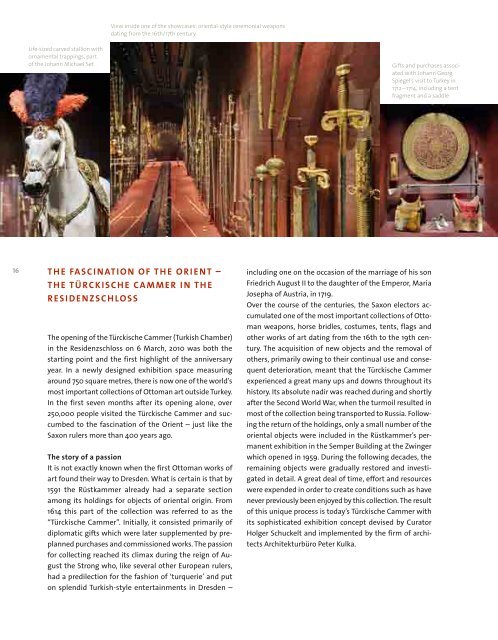Annual Report 2010 - Staatliche Kunstsammlungen Dresden
Annual Report 2010 - Staatliche Kunstsammlungen Dresden
Annual Report 2010 - Staatliche Kunstsammlungen Dresden
Create successful ePaper yourself
Turn your PDF publications into a flip-book with our unique Google optimized e-Paper software.
Life-sized carved stallion with<br />
ornamental trappings, part<br />
of the Johann Michael set<br />
16 tH e FASCI nAtIon oF tH e oRI ent –<br />
tH e tÜ RCKISCH e CAMMeR I n tH e<br />
ReSI DenZSCH loSS<br />
View inside one of the showcases: oriental-style ceremonial weapons<br />
dating from the 16th/17th century<br />
The opening of the Türckische Cammer (Turkish Chamber)<br />
in the Residenzschloss on 6 March, <strong>2010</strong> was both the<br />
starting point and the first highlight of the anniversary<br />
year. In a newly designed exhibition space measuring<br />
around 750 square metres, there is now one of the world’s<br />
most important collections of Ottoman art outside Turkey.<br />
In the first seven months after its opening alone, over<br />
250,000 people visited the Türckische Cammer and succumbed<br />
to the fascination of the Orient – just like the<br />
Saxon rulers more than 400 years ago.<br />
the story of a passion<br />
It is not exactly known when the first Ottoman works of<br />
art found their way to <strong>Dresden</strong>. What is certain is that by<br />
1591 the Rüstkammer already had a separate section<br />
among its holdings for objects of oriental origin. From<br />
1614 this part of the collection was referred to as the<br />
“Türckische Cammer”. Initially, it consisted primarily of<br />
diplomatic gifts which were later supplemented by preplanned<br />
purchases and commissioned works. The passion<br />
for collecting reached its climax during the reign of August<br />
the Strong who, like several other European rulers,<br />
had a predilection for the fashion of ‘turquerie’ and put<br />
on splendid Turkishstyle entertainments in <strong>Dresden</strong> –<br />
Gifts and purchases associated<br />
with Johann Georg<br />
spiegel’s visit to Turkey in<br />
1712 – 1714, including a tent<br />
fragment and a saddle<br />
including one on the occasion of the marriage of his son<br />
Friedrich August II to the daughter of the Emperor, Maria<br />
Josepha of Austria, in 1719.<br />
Over the course of the centuries, the Saxon electors accumulated<br />
one of the most important collections of Ottoman<br />
weapons, horse bridles, costumes, tents, flags and<br />
other works of art dating from the 16th to the 19th century.<br />
The acquisition of new objects and the removal of<br />
others, primarily owing to their continual use and consequent<br />
deterioration, meant that the Türckische Cammer<br />
experienced a great many ups and downs throughout its<br />
history. Its absolute nadir was reached during and shortly<br />
after the Second World War, when the turmoil resulted in<br />
most of the collection being transported to Russia. Following<br />
the return of the holdings, only a small number of the<br />
oriental objects were included in the Rüstkammer’s permanent<br />
exhibition in the Semper Building at the Zwinger<br />
which opened in 1959. During the following decades, the<br />
remaining objects were gradually restored and investigated<br />
in detail. A great deal of time, effort and resources<br />
were expended in order to create conditions such as have<br />
never previously been enjoyed by this collection. The result<br />
of this unique process is today’s Türckische Cammer with<br />
its sophisticated exhibition concept devised by Curator<br />
Holger Schuckelt and implemented by the firm of architects<br />
Architekturbüro Peter Kulka.

















